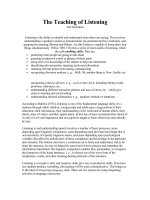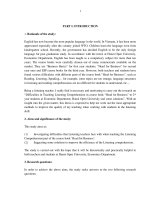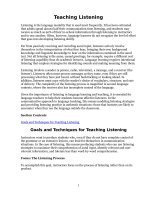TEACHING LISTENING
Bạn đang xem bản rút gọn của tài liệu. Xem và tải ngay bản đầy đủ của tài liệu tại đây (106.11 KB, 21 trang )
TEACHING LISTENING
PRESENTED BY
QUESTIONS FOR DISCUSSION
1. What kinds of listening should be used in
class?
2. Point out some listening problems faced by
your students. Suggest possible solutions
to these problems.
3. Discuss the bottom-up and top-down
processing in teaching listening.
4. Follow-up activity
KINDS OF LISTENING
According to Harmer (1998:98), there are two
kinds of listening material:
Authentic listening material is unscripted
material or pre-recorded announcements,
telephone messages, lectures, plays, news
broadcasts, interviews, other radio program
stories read aloud, etc.
Realistic listening material is scripted
material.
KINDS OF LISTENING (continued)
NOTE
Authentic listening material may cause
problems to students, especially to beginners
because they won’t understand a word;
however it can give students a feel for the
sound of the language and becomes
accustomed to the authentic language that
will facilitate their communication in real life
later on.
KINDS OF LISTENING (continued)
Doff (1995:199) notes that in real life there are
two kinds of listening:
Casual listening: People listen with no
particular purpose in mind , and often without
much concentration (i.e. they do not listen
very closely, and may not remember much of
what they heard)
e.g. Listening to the radio while doing some
housework; chatting to a friend.
KINDS OF LISTENING (continued)
Focused listening: People listen for a particular purpose to find
out information they need to know (i.e. they listen much more
closely for the most important points or for particular
information)
e.g. Listening to a piece of important news on the radio.
Listening to someone explaining how to operate a machine.
NOTE:
According to him, the kind of listening used in class should be
focused listening. Teachers expect students to listen closely
and remember afterwards what they heard.
SOME LISTENING PROBLEMS FACED BY
THE STUDENTS
Students have to go with the speed of the
voice (s) when listening. If they fail to
recognize a word or phrase they have not
understood and stop to think about it, they
often miss the next part of the tape and are
falling behind in terms of comprehension.
SOME LISTENING PROBLEMS FACED BY
THE STUDENTS (continued)
Students might meet problems caused by informal spoken
language which has a number of unique features including the
use of
- Incomplete of utterances (e.g. Dinner? Instead of “Is
dinner ready?”)
- Repetitions (e.g. I’m absolutely sure, absolutely sure you
know that she’s right)
- Hesitations (e.g. yes, well, umm, yes, possibly, but, er…)
- Tone of the voice (high pitch or low pitch)
- The intonation used by the speakers
- Accent
- Background noise
TOP-DOWN AND BOTTOM-UP PROCESSING
In top-down processing, the listener gets a general
view or idea of the listening text by absorbing the
overall picture/ reviewing what he knows about the
topic to interpret the message he has heard.
In bottom-up processing, the listener focuses on
individual words, phrases or cohesive devices and
achieves understanding by stringing these detailed
elements together to build up a whole.
SIX PRINCIPLES BEHIND TEACHING LISTENING
Principle 1: The tape recorder is just as important as
tape.
Principle 2: Preparation is vital.
Principle 3: Once will not be enough.
Principle 4: Students should be encouraged to
respond to the content of a listening, not just to the
language.
Principle 5: Different listening stages demand
different listening tasks.
Principle 6: Good teachers exploit listening texts to
the full.
INTENSIVE LISTENING:
THE ROLE OF THE TEACHER
Organiser
- Teacher gives students a clear and
authentic purpose for listening and
clear instructions about how to
achieve their listening purpose.
INTENSIVE LISTENING:
THE ROLE OF THE TEACHER
Machine operator
-
Teacher should use the tape player as efficiently as
possible; i.e. knowing exactly where the segment he
wishes to use is on the tape and how to get back
there.
-
Teacher should test the recording out before taking it
into class.
-
Teacher should make decisions about where he can
stop the recording for particular questions and in
response to the students’needs.
INTENSIVE LISTENING:
THE ROLE OF THE TEACHER
Feedback organiser
- Teacher should lead a feedback session to
check that students have completed the
listening task successfully.
- Teacher allows them to co-operate and help
each other after listening by having them
compare their answers in pairs. Then he asks
for answers from the class in general or from
pairs in particular.
INTENSIVE LISTENING:
THE ROLE OF THE TEACHER
Prompter
-
Teacher can prompt students to listen to the
recording again to recognize a variety of
language and spoken features or give them
script dictations/ cloze listening to provoke
their awareness of certain language items.
GUIDELINES FOR TEACHING LISTENING IN CLASS
(continued)
Pre-listening (Presentation stage)
Teachers work on the general topic in order to get students to think
about what they already know and in order to establish a reason
for listening.
Teachers might
stimulate students’ interest by setting the scene;
help students by giving them a context by pre-teaching some of
the most difficult language (new words/difficult grammar points/
structures);
encourage them to make predictions about the content of the
text;
give students a clear and authentic purpose for listening;
ask them one/ two guiding questions or engage them in listening
activities.
GUIDELINES FOR TEACHING LISTENING IN CLASS
(continued)
Activities / Tasks
Eliciting
Question- Answer
Exchange
Discussion Predicting
Pre-listening
GUIDELINES FOR TEACHING LISTENING IN CLASS
(continued)
While-listening (practice stage)
Teachers use questions and tasks to practice
appropriate listening skills.
Teachers
allow students to listen to the text (s) twice/ several
times and do the tasks or answer questions;
allow them to co-operate and help each other after
listening;
check their listening comprehension by using
different tasks/ activities/ questions.
While-listening skills
Skills/ Strategies
Listening for gist
(central idea)
Listening for specific
Information (for detail)
GUIDELINES FOR TEACHING LISTENING IN CLASS
(continued)
Post-listening (production stage)
- Teachers show some connection between the
new information and students’ lives.
- Teachers help students improve listening and
speaking skills or writing skills based on the
information and the new language materials
learnt by using a variety of speaking-listening
tasks and activities.
GUIDELINES FOR TEACHING LISTENING IN CLASS
(continued)
Post- listening activities
Activities/ Tasks
Role plays Discussions Story-telling
FOLLOW-UP ACTIVITY
In groups,choose a listening task in TA nang
cao 12 and make a lesson plan. Then
demonstrate your lesson plan.









